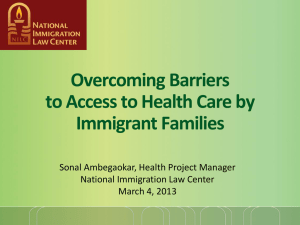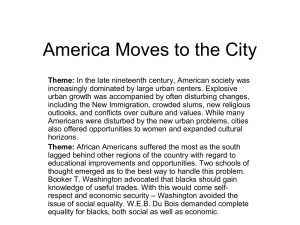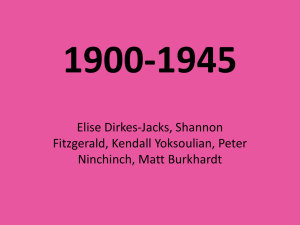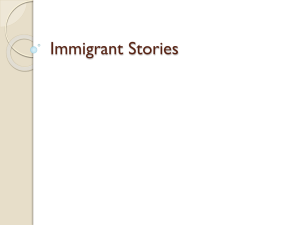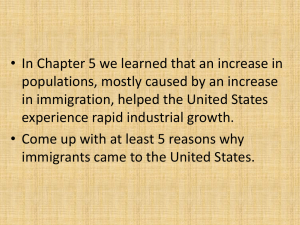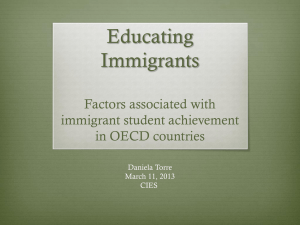Chapter 4 - Urban America
advertisement
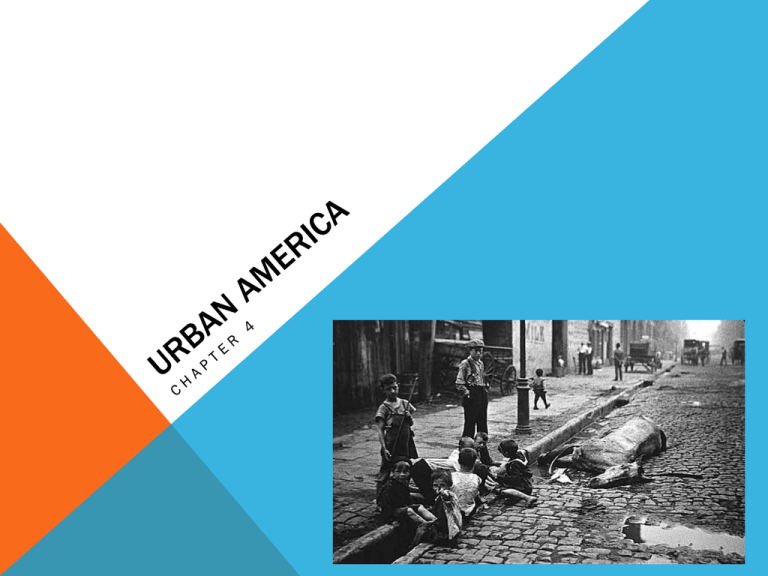
Define each term and then write a sentence using the term in the context of this chapter Americanization Jim Crow Laws Segregation Deflation Nativism Settlement House Graft Political/Party Boss Skyscraper Immigrant Political Machine Social Darwinism Individualism Poll Tax Tenement VOCABULARY Europeans Flood into America: 25 million immigrate to US between1865-1914. More than ½ came from southern Europe (italy, greece, austria-hungary, romania, and serbia) PUSH/PULL of immigration PUSH – something so bad it pushed you away from your homelands * no freedoms, oppression by government/king * no work, can’t support your family * starvation – drought, bad crops, famine PULL – something to good it pulled to you the United States * opportunities – to have a better life than you were born to * freedom – vote, religion, speech, from fear * land ownership – symbol of wealth, power, freedom Most immigration were unskilled, unable to speak English. They needed housing, food and jobs. Some found out quickly, life in America wasn’t going to be easy IMMIGRATION • Atlantic Voyage • Traveled by boat in STEERAGE – below deck, little sanitation or ventilation, packed in • “There is neither breathing space below nor deck room above, and the 900 steerage passengers are packed like cattle. The stenches became unbearable. The food, which is miserable, is dealt out of hug kettles into the dinner pails provided by the steamship company. “ from On the Trail of the Immigrant, 1906 • Ellis Island • Most passed thru Ellis Island in New York Harbor (12 million in 60 years) • A doctor would examine each for disease • Each would be registers (often their names would be “americanized” • Diverse Cities • Big Cities made up of many difference ethnicities • Ethnic groupings like “Little Italy” or the Jewish “Lower East Side” • They spoke the same language, followed the same cultural practices, went to the same churches • These immigrants will change the face of America’s cities and workforce EUROPEAN IMMIGRATION Immigrants from China will flood the West Coast (poverty, unemployment, famine) • Angel Island will be in San Francisco – like Ellis Island • Wait for approval could last for months, detained while they waited • Chinese – faced racism much worse than on east coast • Laborers, servants, skilled tradespeople, merchants • Many opened own businesses to serve people refused by other businesses • Japanese – came for economic opportunities they could not find in Japan • As Japan industrialized, many put out of work ASIAN IMMIGRATION • Wave of immigration led to feeling s of NATIVISM in some • Nativists opposed immigration for many reasons • Backlash against Catholics (would become stronger than Protestants) • Would vote for Catholic officials, often discriminated at work • Labor Unions believed immigrants would undermine American workers ($$, break strikes) • Restrictions on Asian Immigrants • Anti-Chinese bias sometimes led to racially motivated violence • California’s government, then the US government will move to block immigration • 1882 – Chinese Exclusion Act – barred immigration from China for 10 years • CA – “all chinese, japanese, and korean children must attend racially segregated schools • President T. Roosevelt proposed a limit on Japanese immigration in exchange for stopping the segregation in schools. “Gentlemen’s Agreement” made – not formal but agreed to NATIVISM RESURGES Americans migrate to the CITIES (NYC from 800,000 in 1860 to 3.5 million in 1900) * Many were immigrants coming to America for a better life * But many were rural people coming to the cities (jobs, electricity, plumbing , entertainment) * Steel enabled developers to build up (maximizing the profit they could make) SKYSCRAPERS * In Florida, swamps were drained to create more land to develop * Early public transportation systems were built (rail car pulled by horse, trolley cars, subways) * Congestion caused some cities to build elevated rails Separation by Class – poor, middle and upper classes lived in different parts of the city * Early 1800’s, rich built their mansions in heart of city, late 1800’s built out of town (better transportation – “Streetcar Suburbs) * Growing middle class moved away from the city center to escape crime/pollution * Upper classes had maids & servants, freeing up the women to join “Women’s Clubs” that focused on education and social things, will evolve into charitable and reform groups URBANIZATION Most people lived in the poorer parts of town – packed into small, dingy spaces TENEMENTS: dark crowded apartments in which more than one family was packed (borders, extended family, multigenerational families) * most families relied on all members of the family earning a little to contribute * women and children worked outside home to help family survive (low wages) CITY LIVING: posed risk of crime, violence fire disease and pollution * rapid growth made these problems even worse * minor and major crime skyrocketed in packed-in environment * epidemics spread due to poor sanitation and tight quarters CORRUPTION: cities began collecting taxes and spending on program to provide some relief like police protecting, indoor plumbing, clean water * where there is public money, the possibility of corruption grows INNER CITY PROBLEMS DUMBBELL TENEMENTS * POLITICAL MACHINE: informal political group designed to gain power and control over public money - would trade jobs, votes, housing, food and protection for political support • PARTY BOSSES: Men who ran the political machines, often keeping some of the money for themselves - would find jobs, housing, food for “their people” - GRAFT: gaining money or power illegally - accepted bribes to give jobs to contractors at inflated prices - gave jobs/contracts to unqualified friends - “Boss Tweed” one of the more notorious party bosses • Political Machines controlled all/most of the city services • Opponents pointed out corruption and increased costs • Proponents said they provided needed services and helped immigrant assimilate CORRUPTION GILDED AGE: A time of marvels, but also a time of corruption, poverty, crime and great disparities AGE OF INDIVIDUALISM – No matter where you started in life, you could rise up and get as far as your talents and hard work would take you (Horatio Alger – “Rags to Riches” stories) SOCIAL DARWINISM – applying Charles Darwin’s theory to society (Herbert Spencer) * Those who adapt, thrive and move up/on * Those who don’t, whither away and die (Natural Selection) * Industrial leaders used this concept to justify their support for laissez-faire government and their business practices * Darwinism and the Church: Evolutionary theory clashed with the Church’s view of creation. Some more radical thinkers believed evolution was God’s way of creating the world GILDED AGE Carnegie had his own version of “Social Darwinism” - The Gospel of Wealth * People should strive to gain wealth, however possible * Wealthy people should use PHILANTHROPY to help the less fortunate help themselves * Building schools, hospitals, museums, libraries, etc gave the poor a more solid foundation to chase the American dream PRIMARY SOURCE READING: UNDERLINE any key points or ideas CIRCLE any ideas, words that are not clear to you ARROW many key people CARNEGIE’S “GOSPEL OF WEALTH” 1. Identify basic images 1. Look at the words 1. Using your understanding of the timeframe in which this cartoon is set, WHAT DO YOU THINK THE AUTHOR IS TRYING TO SAY/CONVEY? READING A POLITICAL CARTOON Society’s problems caused many to rethink how to address them INDIVIDUALISM, Social Darwinism seemed to clash with compassion ** Challenging Social Darwinism – In an article “Progress and Proverty”, journalist Henry George argued that the rise of “wealth producing power” should have brought an end to poverty * Laissez-faire government and Social Darwinist theory was making it worse Lester Frank Ward - Reform Darwinism – People had succeeded in the universe because of their ability to cooperate. Gov’t COULD regulate economy, promote education and cure poverty Looking Backward – Edward Bellamy book – futuristic look at business and government cooperation creating a Utopian world of no poverty or strife (socialism) Naturalism in Literature – Naturalism theory was that some people failed in life because of the circumstances of their lives. Poverty could crush people and cause them to make poor choices. Nature’s power over civilization THE REBIRTH OF REFORM Social Reform Movement: worked to improve conditions in cities according to biblical ideals of charity and justice. This movement inspired many churches to build gyms, provide social services and child care and, in general, help the poor Salvation Army & the Young Men’s Christian Association (YMCA): combined faith and an interest in reform SA – offered aid and religious counseling to the poor YMCA – helped industrial workers and urban poor by offering bible studies, citizenship training and group activities. It also provided low cost living for young men Settlement House Movement: established centers in poor immigrant neighborhoods. They offered everything from medical care to English classes to kindergartens to recreational programs. HULL HOUSE in CHICAGO HELPING URBAN POOR As US become more industrialized, the need for trained/educated workers increased The number of public schools (no tuition) went from 7.5 M in 1870 to 15.5 M in 1900 Public schools were a crucial link to success for immigrant children. They learned English and American history - “Americanization” Public Schools also taught order and discipline – * separated into grade levels * drilled on punctuality, neatness and efficiencies (job skills) * vocational skills taught in high schools (specific trade/work skills) City children had greater access to public education African American children faced inequalities (segregation, denial of service) PUBLIC EDUCATION Realism – A new movement in literature and art. Artists/Authors wanted to portray the world realistically Thomas Eakins – Artist – painted athletes, surgeons, scientists in action William Dean Howell – “The Rise of Silas Lapham” described the life a of man in Boston trying to get ahead Mark Twain – “Adventures of Huckleberry Finn” showed slavery and southern culture Popular Culture – The standard of living improved enough that people had time/money for entertainment and recreation Saloons – become community social centers Amusement Parks – Coney Island in NY Professional Sports – Baseball, Boxing - - will spread to college sports Recreational Sports – tennis, golf, croquet, basketball (an indoor sport) Vaudeville – skits, animal acts, singers, comedians, acrobats, dancers – short routines Honky -tonks – music echoed pace of life - RAGTIME A CHANGING CULTURE SALOONS AMUSEMENT PARKS: CONEY ISLAND, NY PROFESSIONAL SPORTS RECREATIONAL SPORTS VAUDEVILLE HONKY-TONKS Politics in Washington DC – “Spoils of Office” Spoils System – when a person was elected, it was EXPECTED of him to give jobs to his buddies/supporters (that paid well) in exchange for their loyalty & help * often meant corrupt, inefficient governments & unqualified employees * each newly elected official fired most workers and replaced them with his own Civil Service Reforms – President Chester Arthur assassinated by man who felt he did not get the job he deserved/was promised. Reforms demanded ** Congress passed the Pendleton Act in 1883 + government jobs were categorized by skills needed + applicants would be tested on skills needed + top scorers would be offered the jobs + originally, only about 10% of government jobs were “civil service” jobs + today most government jobs are ‘civil service” jobs POLITICS IN THE GILDED AGE Election of 1884 – the next president, Grover Cleveland tried to please all (some spoils jobs, some reform) angering most * Economics would become issue of the time * Big Powerful Businesses had created unfair advantages for themselves and the Supreme Court had ruled ONLY the federal government could regulate INTERSTATE commerce * Public pressure force Congress to act, passing the INTERSTATE COMMERCE ACT in 1887. This act regulated Railroad fees and other interstate commerce issues * TARIFFS (taxes on imported items) another issue – raised prices & often retaliated against Republicans Gain Power – Big Business backed the Republicans because the Democrats had passed laws that cut into their profits, interfered in their business (wanted high tariffs) * Republican candidate, William H. Harrison, won in one of the closest elections in history * Some tax cuts and tariff raising were passed, intended to protect American made goods backfired, causing a steep rise in prices of all goods * SHERMAN ANTITRUST ACT 1890 – designed to curb the power of Big Business by making monopolies/trusts illegal - when inforced, worked well NEW REFORMS POPULISM: a movement to increase farmers’ political power. Economic swings (prices rising and falling) and overproduction caused the markets to be unstable. Add railroad costs and overseas competition and the farmer had it tough • Money Supply – Increasing the money supply caused inflation (decline in value of the money) causing prices to soar. US gov’t stopped printing “greenbacks”, minting silver stopping inflation but causing deflation (increase in value of money) and a drop in prices • Price swings hurt farmers badly, went further and further into debt • The Grange Takes Action – cooperative of farmers to work to raise prices, get lower costs. Did not work very well, but farmers saw benefits of working together. • The Farmers’ Alliance – the step after the Grange, will use coops to purchase products, market goods. The FA runs into problems when groups won’t work with them (ie-RR) and they try but fail to impact the prices of goods at home/overseas UNREST IN RURAL AMERICA 1. Describe the problems of urban living in the late 1800’s and explain their causes. 2. “Society does not own any man a living… The fact that a man is here is no demand upon other people that they shall keep him alive and sustain him. He has got to fight the battle with nature as every other man has; and if he fights it with the same energy and enterprise and skill and industry as any other man, I cannot imagine his failing – that is, misfortune apart.” William Graham Sumner, testimony before the US House of Representatives, 1879 ** Describe the theory of Social Darwinism as it is reflected in the statement above. ** How is Sumner’s Social Darwinism paralleled by the economic doctrine of laissez-faire? 3. Describe several reasons why Europeans immigrated to the U.S. in the late 1800’s (PUSH/PULL). CHAPTER 4 ESSAYS While the Grange and FA were good starts, they never gain political power to enact change Distrustful of both political parties, they create their own, THE POPULIST PARTY to push for reforms * Unlimited Silver Coinage – would drive prices back up * Federal Ownership of Railroads – would control costs of shipping on railroads * Graduated Income Tax – would tax the wealthy to fund government projects This platform was designed to help the farmers and appeal to organized labor * 8 hour work day * Immigrant restrictions Populist Party issue had little appeal to urban voters (larger group) Will not win many elections, but got issues out there 1896 Election - took political risk to wait until after Rep. and Dem. Conventions and it failed. The Populist Party ended up having to endorse Dem. Candidate William Jennings Bryan (who lost) . After that, the Populist Party declined. They were successful in getting issues out in the open. Some were adopted by Dems/Rep eventually THE RISE OF POPULISM SEGREGATION IN THE SOUTH RECONSTRUCTION IN THE SOUTH: North/gov’t came into South and forced them to give rights to the recently freed African Americans. The South found other ways to block them from achieving power/equality – SHARECROPPING After Reconstruction: * Many (6,000+) AA will flee to the West, where they were judged more on their work ethic than their skin color (EXODUSTERS) * Election of 1876 – ended the Reconstruction Era (north/gov’t pulled out of the South) * TAKING AWAY THE RIGHT TO VOTE – 15th Amendment had extended the right to vote to African American men, but it did not stop states from finding other ways to block the vote POLL TAX – pay to vote – AA were in deep poverty, could not afford to pay to vote LITERACY TESTS – most freed slaves unable to read (had been illegal to teach slaves to read) * LEGALIZING SEGREGATION – used the power of the government to segregate ^^^ Jim Crow Laws – laws that treated whites and blacks differently ^^^ Plessey v. Ferguson (1896) – Separate but Equal will be the standard for the next 60 years RESISTANCE AND SEGREGATION Read p. 136-137 Explain HOW each person reacted to the segregation and violence of the era (take notes on your guided note sheet) * Ida B. Wells * Mary Church Terrell * Booker T. Washington * W.E.B. DuBois USE YOUR BOOKS (P. 136-137) The African American communities responded to violence and discrimination many ways IDA B. WELLS - after hundreds of African American people were lynched, Ida Wells crusades against lynching - She wrote a book depicting lynching and the violence faced in the South - Congress rejected an anti-lynching law, but the exposure caused a drop in lynchings/violence MARY CHURCH TERRELL - worked with suffragist movement, helped found the NAACP - led a boycott against a department store that refused to allow AA to shop in their store CALLS FROM COMPROMINSE – Booker T. Washington called on AA to focus on economic goals rather than political ones. - called AA’s to postpone their push for equal rights until they were ready to use them W.E.B. DuBOIS REJECTS COMPROMISE – believed they had to push for equal rights or they would never receive them – especially the right to VOTE IT WILL BE A LOOOOOOONG STRUGGLE TO ACHIEVE EQUALITY AFRICAN AMERICAN RESPONSE



